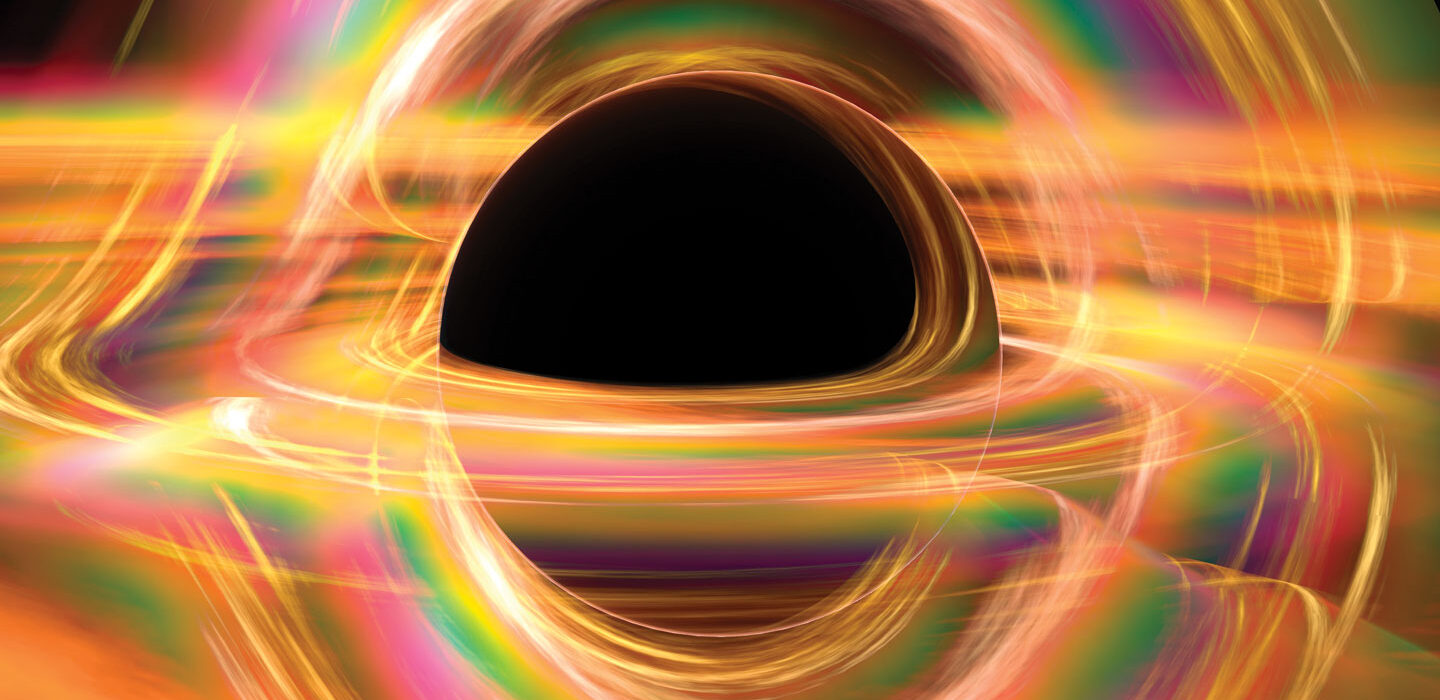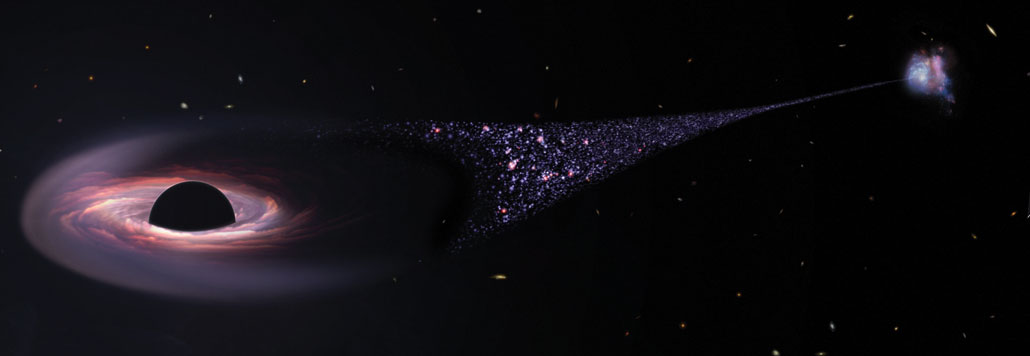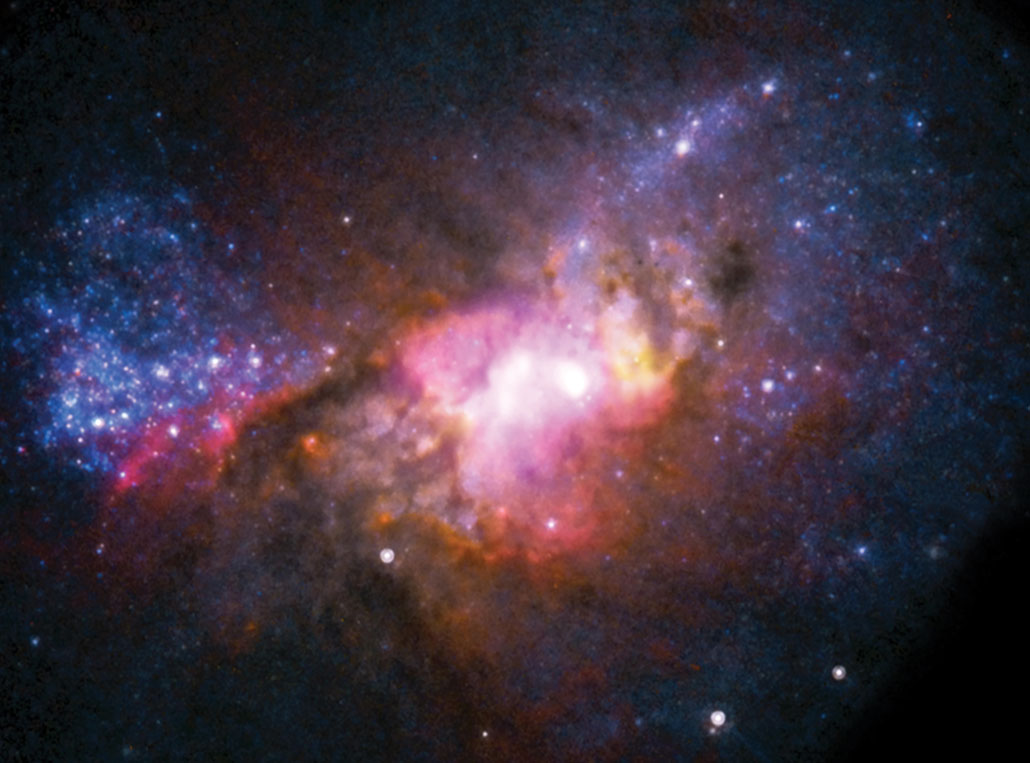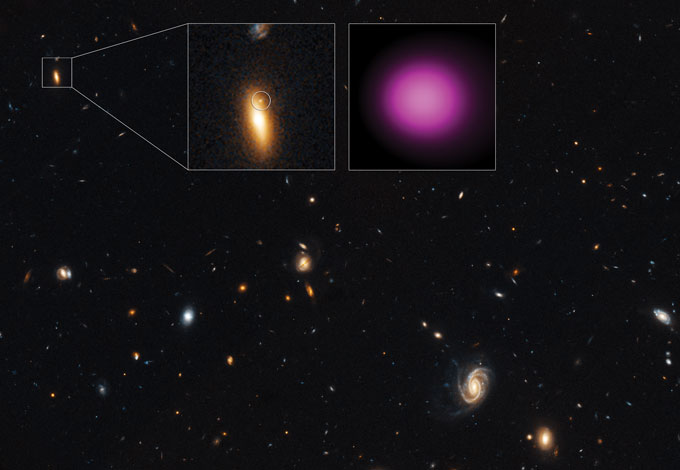Weird black holes may reveal secrets of the early universe
Emerging evidence points to the existence of rogue black holes and other cosmic oddities

Big black holes may not always sit in the hearts of massive galaxies. Recent observations (and computer models) suggest that some are found at the centers of dwarf galaxies.
Alfred Pasieka/Science Photo Library/Getty Images Plus
A black hole at the heart of our galaxy is a hungry monster. This super dense pit of matter weighs as much as 4 million suns. The pull of its gravity is so strong that it has swallowed nearly everything around it. And it gets heftier and heftier the more it eats. In that sense, the Milky Way’s central black hole is a lot like the mythical Kammapa of the Sotho people of southern Africa.
But it’s not alone.
Similar supermassive black holes sit at the centers of nearly all known galaxies. Each one has a mass that’s thousands, millions — sometimes even billions — of times as great as our sun’s. For decades, scientists thought that such cosmic Kammapas could only be found in big galaxies. After all, only massive galaxies were thought to have enough matter to feed these beasts.
How wrong scientists were.
About two decades ago, computer models of the earliest black holes started turning up oddities. In these models, big black holes showed up where they weren’t expected. Many scientists thought those misfits were flukes. But others weren’t so sure. They thought such oddballs should not be ignored.
Now, telescopes have turned up signs of several weirdo black holes. These include massive ones in the tiniest galaxies. Some of these black holes, surprisingly, don’t even seem to sit at their galaxies’ core. Even more intriguing, astronomers have spotted evidence of black holes wandering along the edges of their galaxies. In rare cases, some look like they’re being kicked out of their galaxies altogether.
But perhaps these black holes aren’t just weirdos. Maybe, in fact, they’re big players in the story of our universe. If so, they could help probe one of the greatest mysteries of all. How did these cosmic Kammapas develop?

Little galaxies can have big black holes
Our current understanding of how black holes get so big goes something like this. In the early universe, the cores of baby galaxies had baby black holes. Over time, galaxies grew, smashed into each other and merged. As they did so, the galaxies took on gobs of new stars, gas and dust. Meanwhile, the black holes in their centers merged and fed on all the new material.
As a result, as galaxies grew, so did their central black holes.
In this scenario, the black hole at the center of each galaxy should be around one thousandth of the mass of its galaxy.
Not all of today’s galaxies are as big as our Milky Way. Some “dwarf galaxies” have only about a trillionth its mass. In order to have stayed so small, they must not have merged with many other galaxies. Each dwarf galaxy’s black hole would likely have escaped merging with many other black holes.
By that logic, the black holes in dwarf galaxies should be runts — or nonexistent.
But computer models in the late 2000s started to cast doubt on this logic.
Those models showed how massive black holes could have evolved over the history of the universe. Even the smallest galaxies, they showed, could have large black holes — and right away. Some of those galaxies never grew or merged with any others. This left the galaxies small with big black holes for billions of years.
Astronomer Amy Reines found the first hints that such galaxies exist. More than a decade ago, she was looking through telescope data on a dwarf galaxy 30 million light-years from Earth. There, she spied extreme amounts of radio light and bright X-rays. That intense radiation signaled the presence of a huge black hole.
“I hadn’t seen this before,” recalls Reines, who now works at Montana State University in Bozeman. Like other scientists, she had assumed dwarf galaxies weren’t big enough to have big black holes.
But a few months later, in 2011, Reines went to a meeting of scientists. There, she heard astrophysicist Jillian Bellovary speak. Bellovary presented some new models of galaxy formation. These suggested that even scrawny galaxies could have hefty black holes.
Reines was shocked to find her observations and Bellovary’s models seemed to match.
Not long after that, Reines launched an effort to find more dwarf galaxies with outsized black holes. She is part of a team that scanned roughly 25,000 dwarf galaxies. Of those, 151 seemed to harbor a big black hole. The team shared its findings in 2013.

Weighing origin stories for black holes
If models like Bellovary’s were right, the observed dwarf galaxies with big black holes most likely formed that way in the early universe. Since then, they’ve been relatively untouched by mergers.
If true, looking at these ancient relics might tell us something about the very first generation of black holes to exist. That includes those that eventually grew into today’s supermassive monsters, such as the one at the center of the Milky Way.
For instance, the mass of a black hole in some dwarf galaxy should be similar to the mass of some of the earliest black holes. So looking at black holes in dwarf galaxies could help astronomers figure out the starting mass of the original black holes. That, in turn, could help scientists tease out how those first black holes formed.
Right now, there are two leading ideas for how the first black holes developed. Each idea creates black holes of different masses.
The first idea has black holes forming as the first stars collapsed. This process would tend to create pretty lightweight black holes. The other idea: Those first black holes could have formed from giant gas clouds that collapsed in on themselves. Those black holes should start out heavier.
The dwarf galaxy that Reines observed seems to have a mass equal to a few million suns. That’s pretty heavy. It’s one point in favor of the cloud-collapse idea. But it’s just one data point. And measuring the mass of black holes is not easy.
Luckily, there are other clues scientists can use to learn how the first black holes formed. These hints come from an even odder type of black hole: massive ones that don’t sit right at the centers of their dwarf galaxies.
Wandering black holes
Remember Bellovary’s computer models of the earliest black holes? Big black holes in scrawny galaxies weren’t the only surprise her models turned up. Those models also suggested that some of those large black holes wandered near the edges of dwarf galaxies.
“I always like to think about the outliers, or the weird little rejects,” says Bellovary. She’s now based at Queensborough Community College in New York City.
Bellovary reran her models. She zoomed in on the littlest galaxies. When she did, half of the massive black holes in dwarf galaxies would be off-center. She and her colleagues shared this finding in 2019.
As if on cue, a few months later Reines had data to support those models. Her team’s observations came from radio telescopes in New Mexico known as the Very Large Array. The researchers peered at 111 dwarf galaxies. Thirteen most likely had big black holes. Of those 13, a few seemed to sit off-center from their galaxies’ cores.

Finding wanderers was a jackpot. “Once a black hole starts wandering, it does not grow in mass anymore,” says Marta Volonteri. That means stray black holes should match the starting masses of the first black holes even more closely than those at the centers of dwarf galaxies. Volonteri is an astrophysicist. She works for the Institute of Astrophysics in Paris, France. It’s at Sorbonne University.
Sadly, weighing wandering black holes is even harder than weighing ones at their galaxies’ cores. That makes it difficult to judge whether they match the star-collapse or cloud-collapse theory, based on their weight. But the overall number of wanderers can offer hints about how they formed.
Studying weirdos
If the earliest black holes formed from huge gas clouds collapsing, then wanderers should be pretty rare in dwarf galaxies. That’s because converting a gas cloud into a black hole is quite hard. So that should make it a rare event. If the first black holes came from collapsing stars, though, they should be more common. The reason is that stars can collapse into black holes pretty easily.
Signs of wanderers keep popping up. That has researchers leaning away from the cloud-collapse idea. But scientists don’t just want to know how the first black holes formed. They also want to know how some of them grew to become among the most massive black holes.
To find out, astronomers must look to a different type of cosmic weirdo.
Dwarf galaxies aren’t the only ones with wandering black holes. Some massive galaxies appear to have them too. And some of those wanderers — or rogues — seem to be flying across their host galaxies at 10 times the speed of wanderers in dwarf galaxies.
Such sprinting rogues turned up in models, such as Bellovary’s. Several years ago, the Hubble Space Telescope and other observatories also saw evidence of a huge black hole getting booted to the edge of its galaxy. Earlier this year, Hubble and the Keck Observatory might have seen the aftermath of a trio of interacting supermassive black holes. One of them seemed to have been kicked out of its galaxy.
Not all scientists have accepted those data as evidence that rogue black holes exist. But if they do, rogues could help explain how today’s biggest black holes grew up.
Imagine that astronomers find many slow-moving wanderers. Those black holes probably haven’t interacted with any others. Otherwise, they would have picked up an extra zing of speed. If astronomers find many black holes that haven’t interacted with others, that might mean interactions between big black holes are rare. It would follow, then, that mergers between big black holes are rare. And that would put a damper on scientists’ current idea that supermassive black holes grew through repeated mergers.
Now imagine the opposite. Lots of supermassive black holes are being shot out from the centers of their galaxies. That would suggest black hole interactions are pretty common. In turn, black hole mergers would likely be common, too. That would support the current merger theory of how the biggest black holes came to be.
The search continues
The complete story of cosmic Kammapas remains a mystery. So far, scientists have little to go on — only a few dozen possible oddballs in dwarf galaxies and a few possible far-flung rogues. More data would help clear things up. Luckily, more astronomers have joined the search.
Future observatories may aid in the hunt, too. The Vera C. Rubin Observatory is supposed to turn on next year. That telescope in Chile could sweep the skies looking for wanderers. And the Laser Interferometer (In-tur-fur-AAHM-eh-tur) Space Antenna, or LISA, will try to detect massive black-hole smashups.
Time and new technology may someday tell all. For now, oddball black holes spark our imaginations. They prompt us to ask big questions and to look for evidence that may help us better understand our cosmos’ history.
With each discovery, you can’t help but wonder: What else is hidden out there? Perhaps there are other oddities not yet discovered that could help explain the early universe, Bellovary says. But only if we’re willing to chase the misfits and their stories.







